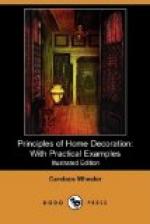Irregularly placed floating forms of Persian or Arabic design are often admirably stencilled in colour upon a painted wall; but in this case the colours should be varied and not too strong. A group of forms floating away from a window-frame or cornice can be done in two shades of the wall colour, one of which is positively darker and one lighter than the ground. If to these two shades some delicately contrasting colour is occasionally added the effect is not only pleasing, but belongs to a thoroughly good style.
One seldom tires of a good stencilled wall; probably because it is intrinsic, and not applied in the sense of paper or textiles. It carries an air of permanency which discourages change or experiment, but it requires considerable experience in decoration to execute it worthily; and not only this, there should be a strong feeling for colour and taste and education in the selection of design, for though the form of the stencilled pattern may be graceful, and gracefully combined, it must always—to be permanently satisfactory—have a geometrical basis. It is somewhat difficult to account for the fact that what we call natural forms, of plants and flowers, which are certainly beautiful and graceful in themselves, and grow into shapes which delight us with their freedom and beauty, do not give the best satisfaction as motives for interior decoration. Construction in the architectural sense—the strength and squareness of walls, ceilings, and floors—seem to reject the yielding character of design founded upon natural forms, and demand something which answers more sympathetically to their own qualities. Perhaps it is for this reason that we find the grouping and arrangement of horizontal and perpendicular lines and blocks in the old Greek borders so everlastingly satisfactory.
It is the principle or requirement, of geometric base in interior design which, coupled with our natural delight in yielding or growing forms, has maintained through all the long history of decoration what is called conventionalised flower design. We find this in every form or method of decorative art, from embroidery to sculpture, from the Lotus of Egypt to the Rose of England, and although it results in a sort of crucifixion of the natural beauty of the flower, in the hands of great designers it has become an authoritative style of art.
Of course, there are flower-forms which are naturally geometric, which have conventionalised themselves. Many of the intricate Moorish frets and Indian carvings are literal translations of flower-forms geometrically repeated, and here they lend themselves so perfectly to the decoration of even exterior walls that the fretted arches of some Eastern buildings seem almost to have grown of themselves, with all their elaboration, into the world of nature and art.
The separate flowers of the gracefully tossing lilac plumes, and the five-and six-leaved flowers of the pink, have become in this way a very part of the everlasting walls, as the acanthus leaf has become the marble blossom of thousands of indestructible columns.




